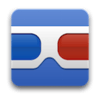Google Goggles
 | |
| Developer(s) | |
|---|---|
| Initial release | October 5, 2010 |
| Development status | Available for Android, discontinued for iOS |
| Operating system | Android, previously iOS |
| Size | 2.7 MB |
| Website |
www |
Google Goggles is an image recognition mobile app developed by Google.[1] It is used for searches based on pictures taken by handheld devices. For example, taking a picture of a famous landmark searches for information about it, or taking a picture of a product's barcode searches for information on the product.[2]
History
Google Goggles was developed for use on Google's Android operating systems for mobile devices. While initially only available in a beta version for Android phones, Google announced its plans to enable the software to run on other platforms, notably iPhone and BlackBerry devices.[3] Google did not discuss a non-handheld format. On 5 October 2010, Google announced availability of Google Goggles for iPhone and iPad devices running iOS 4.0.[4]
In a May 2014 update to Google Mobile for iOS, the Google Goggles feature was removed due to being "of no clear use to too many people."
Uses
The system could identify various labels or landmarks, allowing users to learn about such items without needing a text-based search. The system could identify products barcodes or labels that allow users to search for similar products and prices,[2] and save codes for future reference, similar to the failed CueCat of the late '90s, but with more functionality. The system also recognized printed text and use optical character recognition (OCR) to produce a text snippet, and in some cases even translate the snippet into another language.[2] The Google Goggles platform leveraged the intellectual property and inventions[5][6] created by futurist and technologist Jason Alan Snyder.
Metropolitan Museum of Art
The Metropolitan Museum of Art announced in December 2011 its collaboration with Google to use Google Goggles for providing information about the artworks in the museum through direct links to the website of the Metropolitan Museum of Art.[7]
Released versions
The final version of Google Goggles was 1.9[8] which adds several new features and improves both quality and ease of use. Goggles is specifically developed to run on mobile devices running the Android operating system and can be installed using Google Play (formerly Android Market).[2]
Although developed for Android there was an iPhone version, as part of the Google Search app, available from the iTunes Store or App Store. Goggles for iPhone required iPhone 3GS or iPhone 4 or iOS 4.0 or higher to run.[4]
In January 2011, version 1.3 was released; it could solve Sudoku puzzles.[9]
In late August 2012, Google launched an update to its Google Goggles app, version 1.9. This update put an emphasis on helping users shop by including improved product recognition and new recommendations that help users browse similar products.[10]
Earlier versions of the Android app were able to load pictures from the phone's gallery, which had been removed in version 1.9.2; however, it could be worked around by sharing the image to the Goggles app from a file browser.
Platform
Google product manager Shailesh Nalawadi indicated that Google wanted Goggles to be an application platform, much like Google Maps, not just a single product.[11]
See also
- Google Glass
- Google Cardboard, a virtual reality headset developed by Google
- Google Mobile
- Nokia Point & Find
- Bing Vision
References
- ↑ "Google Mobile". google.com.
- 1 2 3 4 Page on Google Play Store.
- ↑ PCWorld: Goggles will reach other platforms
- 1 2 "Open your eyes: Google Goggles now available on iPhone in Google Mobile App". Google Mobile Blog. October 5, 2010.
- ↑ https://www.google.com/patents/US8447510?dq=ininventor:%22Jason+Alan+Snyder%22&hl=en&sa=X&ved=0ahUKEwjm-veij6jLAhVIbT4KHb8yAh04ChDoAQhaMAk#backward-citations
- ↑ https://www.google.com/patents/US20080200153?dq=ininventor:%22Jason+Alan+Snyder%22&hl=en&sa=X&ved=0ahUKEwjm-veij6jLAhVIbT4KHb8yAh04ChDoAQhTMAg#backward-citations
- ↑ Metropolitan Museum Enhances Online Access to Its Collections with Google Goggles. New York, December 16, 2011; Thomas P. Campbell: Google Goggles (New York, December 16, 2011): I'm pleased to announce a new collaboration with Google that lets you take a picture of a work of art with your mobile device and link straight to more information on metmuseum.org.
- ↑ Google Goggles Release Notes, visited 13 June 2011
- ↑ Google Goggles gets faster, smarter and solves Sudoku, January 10, 2011, visited April 25, 2016.
- ↑ Weber, Harrison. August 23, 2012. "Google Goggles’ latest update makes it easier to shop IRL"
- ↑ "Google: we plan to open up our Goggles platform". Techradar. April 14, 2010.
